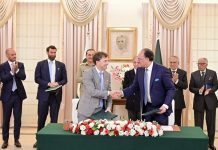KARACHI: The Sindh government has identified that economic regeneration hinges on investing in a healthy and competitive urban sector and developing complementary and supportive strategies for strengthening the interface between urban and rural Sindh, including its large urban centres and small towns, reports media.
The government will intensify its efforts to promote industrialization for the welfare of the people, according to a policy document. It highlights that industrialization has been crucial to the economic growth of developed countries, but unfortunately, the growth of the industrial sector in Pakistan has not seen a significant rise in recent years.
In the case of Sindh, the past decades have exhibited a consistent decline due to various factors. These include instability, such as law and order issues, inconsistent political and economic policies, severe energy problems, power shortages, inadequate infrastructure, high production costs, lack of investment, labor unrest, under-utilization of capacity, economic power concentration, consumption trends, and public sector performance.
The policy document highlights that the current state of industrial growth necessitates the development of a comprehensive industrial development strategy to ensure sustainable growth in the province.
To address these challenges, the government is crafting a strategy aimed at the optimal use of Sindh’s human and material resources for sustainable industrial growth. This strategy seeks to significantly bolster the province’s economic foundation and create new jobs and better employment opportunities.
The document notes that due to the lack of development in secondary cities within Sindh, public funding for infrastructure development has been sporadic, leading to uninformed ad-hoc decisions. Consequently, intermediary cities have been unable to fulfill their potential as “Engines of Economic Growth.”
Although cities are typically engines of growth, in Sindh, overall urban development and management remain weak. Intermediary cities have not successfully driven economic growth, leading to increased poverty in remote areas due to limited economic opportunities and social services. The poverty headcount ratio in these areas is nearly double that of large metropolitan cities.
Sindh is the second-largest and most urbanized commercial hub of Pakistan. Strategically, it boasts two seaports and an international airport, serving as a gateway to significant economic activities and revenue generation for Pakistan.
Stretching about 579 km from north to south and nearly 442 km at its widest (281 km on average), Sindh covers an area of 140,915 square kilometers. It is the second-largest province, playing a crucial role in the national economic and development agenda.
Karachi, the financial capital of the country, encompasses 23.7 percent of Pakistan’s population and 18.34 percent of its land area. –INP




